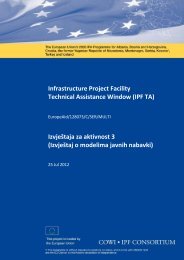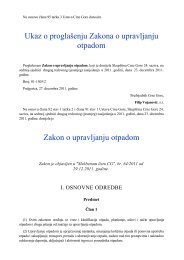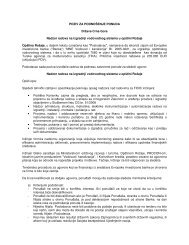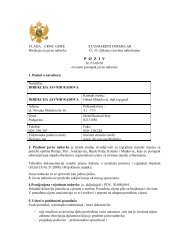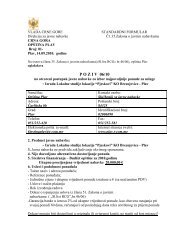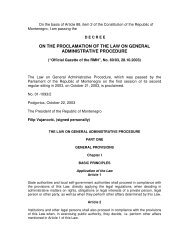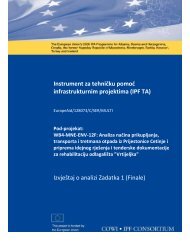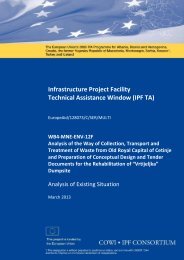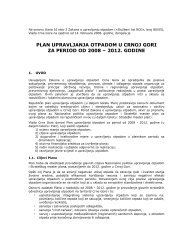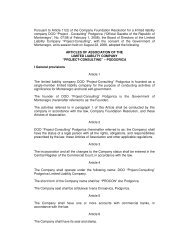Infrastructure Projects Facility Technical Assistance Window (IPF TA ...
Infrastructure Projects Facility Technical Assistance Window (IPF TA ...
Infrastructure Projects Facility Technical Assistance Window (IPF TA ...
You also want an ePaper? Increase the reach of your titles
YUMPU automatically turns print PDFs into web optimized ePapers that Google loves.
<strong>Infrastructure</strong> <strong>Projects</strong> <strong>Facility</strong> – <strong>Technical</strong> <strong>Assistance</strong> <strong>Window</strong><br />
Sub project: WB4-MNE-ENV-12B: Management Models and Options for Cost Recovery for the Future Construction and<br />
Operation of Regional Landfills in Montenegro<br />
21<br />
• lack of sufficient capacities of public utility companies as the main providers<br />
of municipal waste collection and disposal services<br />
• selection of sites for future regional landfills that are acceptable to the local<br />
population from the point of view of environmental protection and which<br />
incur the lowest costs<br />
• implementation of new regulations and necessary improvements in managing<br />
hazardous and industrial waste.<br />
The Republic-Level Solid Waste Strategic Master Plan, the National Waste<br />
Management Policy and the Law on Waste Management are aimed at addressing<br />
above mentioned issues, leading to the conclusion that successful implementation<br />
of these polices will improve the state of the waste sector in the<br />
country. In these respects, the main goals of the NSSD in waste management<br />
are the further harmonization of national legislation with EU legislation,<br />
strengthening capacities for waste management, construction of sanitary landfills,<br />
raising awareness on waste separation and recycling, and enhancing the<br />
waste database.<br />
4.3.4 Spatial Plan of Montenegro until 2020<br />
The Spatial Plan of Montenegro until 2020 sets the national objectives and<br />
measures for spatial development, in line with economic, ecological, socioeconomic<br />
and cultural-historic development. Furthermore, the Spatial Plan defines<br />
general and specific principles of spatial development, in accordance with<br />
sustainable development principles, and provides guidelines for the development<br />
of sectoral policies and detailed spatial planning documents at the state<br />
and local levels.<br />
Scope<br />
The Spatial Plan of Montenegro envisions the spatial development of the<br />
country in response to the actual needs of the population as well as to recent<br />
changes and future trends. Two main pillars constitute the spatial development<br />
of the country, reflecting different requirements of the same process:<br />
• regionalization of the development perspective<br />
• further integration of the Montenegrin space.<br />
Classification<br />
The Spatial Plan specifies three regions of Montenegro:<br />
• Coastal Region – development zones of Boka Kotorska Bay, Central Coast<br />
and Southern Coast.<br />
• Central Region – development zones of Zeta and Bjelopavlići Plain, Nikšić<br />
and Cetinje area constituting lowlands surrounded by karst areas. The largest<br />
part of industry, the best agricultural land and the main centres of services,<br />
cultural and other tertiary activities, excluding tourism, are concentrated<br />
in this region. The present spatial structures and conditions in the<br />
Central Region require an appropriate organization of the space in the light<br />
of the industrial restructuring processes and pressure on agricultural land.<br />
.



